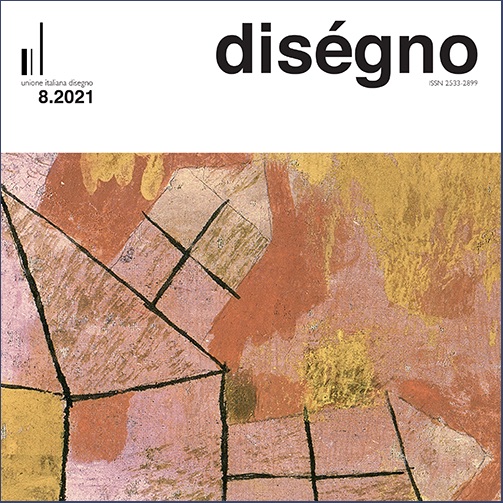Aspetti e criticità della fruizione in soggettiva dello spazio digitale: la "vista in prima persona”
DOI:
https://doi.org/10.26375/disegno.8.2021.20Parole chiave:
vista in prima persona, prospettiva, percezione, real-time 3D, musei virtualiAbstract
La ricerca qui illustrata nasce da una riflessione critica sul tema della “vista in prima persona”, così come definita nell’ambito delle rappresentazioni tridimensionali digitali virtuali interattive. Una riflessione scaturita dalla meraviglia percettiva, comunicativa, illusoria e narrativa, propria delle prospettive architettoniche seicentesche, a contrasto con la più esile – rispetto alle forze in gioco - efficacia suggestiva degli scenari caratteristici dell’odierna fruizione prospettica immersiva digitale. Attraverso una fase analitica di osservazione dell’esperienza naturale del vedere e del muoversi nello spazio del mondo reale, si è cercato di individuare alcune macroscopiche criticità e lacune funzionali, oggi volutamente o singolarmente trascurate nella implementazione della fruizione dello spazio tridimensionale digitalmente simulato. Sono stati così individuati, nonché descritti nei caratteri salienti, tre macro ambiti di potenziale intervento e, per ognuno di essi, sono stati focalizzati alcuni fattori qualitativi emergenti, la cui cura può perfezionare l'esperienza di fruizione tridimensionale e, per conseguenza, l’attività conoscitiva dello spazio virtuale digitale, così come della informazione in esso contenuta. Obbiettivo finale della ricerca è infatti perfezionare e personalizzare la fruizione virtuale di spazi museali digitali.
Riferimenti bibliografici
Amoruso, G. (2020). disegnare con… Laura Marcolini. In DisegnareCon, vol. 13, n. 25.
Antinucci, F. (1998). Musei e nuove tecnologie: dov’è il problema? In Sistemi intelligenti, vol. X, n. 2, pp. 281-306.
Bergamin, K., Clavet, S., Holden, D., Forbes, J. R. (2019). DReCon: datadriven responsive control of physics-based characters. In ACM Trans. Graph., vol. 38, n. 6, Article 206.
Boletsis, C., Cedergren, J. E. (2019). VR locomotion in the new era of virtual reality: an empirical comparison of prevalent techniques. In Advances in Human-Computer Interaction, vol. 2019. <https://doi.org/10.1155/2019/7420781> (accessed 2021, May 12).
Casale, A. (2018). Forme della percezione: dal pensiero all’immagine. Roma: Franco Angeli.
Eugeni, R., Guerra, M. (2020). Far sentire la macchina. Appunti sulla soggettiva cinematografica e la teoria dell’enunciazione. In E/C, anno XIV, n. 29, pp. 134-144.
Modena, E. (2019). Musei nei videogiochi| Videogiochi nei musei. In Piano B Arti e culture visive, n. 4, pp. 83-105.
Nielsen, L. T., et al. (2016). Missing the point: an exploration of how to guide users’ attention during cinematic virtual reality, In S. N. Spencer (ed.). VRST 2016. Atti del 22nd ACM Conference on Virtual Reality Software and Technology, Monaco, Germania, 2-4 novembre, pp. 229-232. New York: Association for Computing Machinery Inc.
Nirkin, Y., Keller, Y., Hassner, T. (2019). FSGAN: Subject Agnostic Face Swapping and Reenactment, In IEEE/CVF 2019. Proceedings International Conference on Computer Vision, Seul, Corea, 27 ottobre-2 novembre, pp. 7184-7193: <https://openaccess.thecvf.com/content_ICCV_2019/paper s/Nir kin_FSGAN_Subject_Agnostic_Face_Swapping_and_Reenactment_ICCV_2019_paper.pdf> (accessed 2021, May 12).
Paes, D., Arantes, E., Irizarry, J. (2017). Immersive environment for improving the understanding of architectural 3D models: Comparing user spatial perception between immersive and traditional virtual reality systems. In Automation in Construction, n. 84, pp. 292-303.
Schwartz, L. (2006). Fantasy, realism, and the other in recent video games, In Space and culture, n. 9, pp. 313-325.
Sun, Q., et al. (2018). Towards Virtual Reality Infinite Walking: Dynamic Saccadic Redirection. In ACM Trans. Graph., vol. 37, n. 4. <https://doi.org/10.1145/3197517.3201294> accessed 2021, May 12).
Trevisan, E. (2015). Il san Giovanni Evangelista di Jean François Niceron: la scoperta di un’apocalisse dell’Ottica. In G. M. Valenti (a cura di), Prospettive Architettoniche, pp. 365-374 Roma: Sapienza Edizioni.
##submission.downloads##
Pubblicato
Come citare
Fascicolo
Sezione
Licenza
Copyright (c) 2021 diségno

TQuesto lavoro è fornito con la licenza Creative Commons Attribuzione 4.0 Internazionale.






